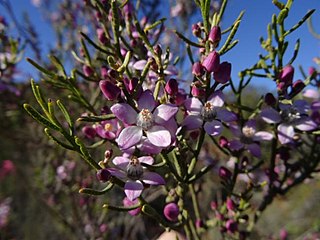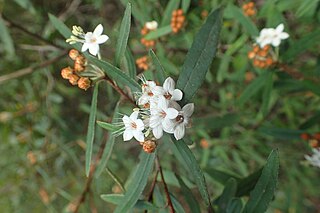
Pennisetum is a widespread genus of plants in the grass family, native to tropical and warm temperate regions of the world. They are known commonly as fountaingrasses. Pennisetum is considered a synonym of Cenchrus in Kew's Plants of the World Online.

Eriostemon is a genus of flowering plants of the family Rutaceae. It is native to eastern Australia and includes just two species, Eriostemon australasius and Eriostemon banksii. Eriostemon australasius, commonly known as pink wax flower, occurs between Fraser Island and Nowra and is a shrub of heathlands and low open woodlands. Eriostemon banksii is endemic to Cape York Peninsula and is a shrub or small tree occurring in heathland and rainforest margins.

Heliopsis is a genus of herbaceous flowering plants in the sunflower family, native to dry prairies in North and South America. The sunflower-like composite flowerheads are usually yellow, up to 8 cm (3 in) in diameter, and are borne in summer. Species are commonly called ox-eye or oxeye.

Exostema is a genus of flowering plants in the family Rubiaceae. It consists of trees and shrubs, endemic to the neotropics, with most of the species occurring in the West Indies.

Verticordia halophila, commonly known as salt-loving featherflower, or salt-loving verticordia, is a flowering plant in the myrtle family, Myrtaceae and is endemic to the south-west of Western Australia. It is an erect, bushy shrub with small, crowded, thick leaves and spikes of red and pink flowers in spring.
Trachys is a genus of Asian plants in the grass family.

Jaumea is a genus of flowering plants in the daisy family. The plants are sprawling perennial herbs branching mostly from the base. Flower heads are yellow, with disc flowers and also usually with ray flowers.
Chrysanthellum is a genus of flowering plants in the aster family.

Persoonia levis, commonly known as the broad-leaved geebung, is a shrub native to New South Wales and Victoria in eastern Australia. It reaches 5 m (16 ft) in height and has dark grey papery bark and bright green asymmetrical sickle-shaped leaves up to 14 cm (5.5 in) long and 8 cm (3.2 in) wide. The small yellow flowers appear in summer and autumn, followed by small green fleshy fruit, which are classified as drupes. Within the genus Persoonia, it is a member of the Lanceolata group of 58 closely related species. P. levis interbreeds with several other species where they grow together.

Leucopogon juniperinus, also known as prickly beard-heath, is a common shrub found in eastern Australia. Found on a variety of soil types and habitats in eucalyptus woodland or forest. Often seen on more fertile sedimentary based clay soils.

Persoonia laurina, commonly known as the laurel-leaved or laurel geebung, is a shrub of the family Proteaceae native to central New South Wales in eastern Australia. Found in sclerophyll forest, it grows to a height of 2 metres. The yellow flowers appear in late spring.

Persoonia hirsuta, commonly known as the hairy geebung or hairy persoonia, is a plant in the family Proteaceae and is endemic to eastern New South Wales. It is a hairy, spreading to low-lying shrub with linear, lance-shaped or spatula-shaped leaves and yellow or orange flowers arranged singly or in groups of up to ten on a rachis up to 20 mm (0.79 in) long.
Philotheca pungens, commonly known as prickly waxflower, is a species of flowering plant in the family Rutaceae and is endemic to south-eastern Australia. It is an undershrub with linear to narrow oblong or needle-like leaves and white flowers usually arranged singly in leaf axils.

Ottelia is a genus of an aquatic plant family Hydrocharitaceae described as a genus in 1805. The genus is native to tropical and subtropical regions of Africa, Asia, South America, and Australia.

Philotheca brucei is a species of flowering plant in the family Rutaceae and is endemic to Western Australia. It is a shrub with cylindrical leaves grooved along the top and in spring, white to pink or mauve flowers with five egg-shaped petals.

Pultenaea tuberculata, commonly known as the wreath bush-pea, is a flowering plant in the family Fabaceae. It has yellow and red pea flowers and is endemic to Australia.

Phebalium woombye, commonly known as wallum phebalium, is a species of shrub that is endemic to eastern Australia. It has branchlets covered with scales and star-shaped hairs, elliptical leaves, and white to pink flowers arranged in umbels of four to ten flowers.
Leionema oldfieldii is a small shrub that is endemic to mountainous locations in Tasmania, Australia. It has dark green leaves, compact pale pink to white flowers from November to January.

Philotheca myoporoides subsp. myoporoides, commonly known as long-leaf wax flower, is a subspecies of flowering plant in the family Rutaceae and is endemic to south-eastern continental Australia. It is a shrub with oblong to elliptic or egg-shaped leaves and white or pink flowers arranged in groups of three to eight in leaf axils.

Philotheca virgata, commonly known as Tasmanian wax-flower, is a species of flowering plant in the family Rutaceae and is endemic to south-eastern Australia. It is a slender, erect shrub with wedge-shaped to oblong leaves and white or pale pink flowers at the ends of branchlets. It is the only philotheca with four sepals and petals.

















